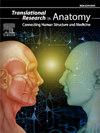茎突延长(Eagle综合征)显微ct分析与临床回顾的解剖学研究
Q3 Medicine
引用次数: 0
摘要
eagle综合征是一种罕见的疾病,通过成骨(I型)或茎突舌骨韧带(SHL)骨化(II型)导致颞骨茎突(SP)伸长(30mm)。Eagle综合征累及茎突,可引起吞咽困难、颈部运动疼痛、颈内动脉夹层和中风。关于Eagle综合征大体解剖和SP显微结构的报道很少。本研究通过大体和显微ct分析对1例人尸体的鹰综合征SPs进行研究,并探讨其临床意义。方法本病例是在对一具成年男性尸体进行常规学术解剖时发现的。双侧检查茎突器官有无非典型形态。SPs被剥去外部组织并拍照。测量SP的线性和角度尺寸,并对右侧SP切片进行显微ct分析。根据现有文献,对Eagle综合征的病因学、流行病学、症状学、诊断参数、亚型描述和治疗进行综合综述,作为临床讨论的基础。结果右、左SP长轴直径分别为41.4 mm和33.0 mm,近端、中端和远端SP长轴直径分别为4.2 mm、3.5 mm和1.7 mm。两种SPs均表现为中轴结节,此后在2 mm距离内直径减小25%以上,矢状面下降角增加20.0°以上,表面特征明显不同。显微ct分析显示整个SP的小梁和皮质结构相对一致。结论SP增生与SHL化生的临床认识,因为它适用于Eagle综合征的病因和随后对茎突器官的影响,对Eagle综合征的诊断、治疗和患者预后都很重要。由于Eagle综合征可以表现出广泛的症状,本报告可以为初级保健医生、牙医、神经科医生、放射科医生、耳鼻喉科医生和其他医疗专业人员提供信息,用于改进Eagle综合征患者的诊断测试和治疗方法。本文章由计算机程序翻译,如有差异,请以英文原文为准。
Anatomical investigation of elongated styloid processes (Eagle syndrome) with micro-CT analysis and clinical review
Introduction
Eagle syndrome is a rare disease that causes elongation (>30 mm) of the temporal styloid process (SP) through osteogenesis (Type I) or ossification of the stylohyoid ligament (SHL) (Type II). Eagle syndrome implicates the styloid apparatus and can cause difficulty with swallowing, pain with neck movement, dissection of the internal carotid artery, and stroke. Reports investigating the Eagle syndrome gross anatomy and SP microstructure are scarce. This study seeks to investigate a case of Eagle syndrome SPs in a human cadaver with gross and micro-CT analysis and discuss its clinical significance.
Methods
The case was discovered during routine academic dissection of an adult male human cadaver. The styloid apparatus was examined bilaterally for any non-typical morphologies. The SPs were stripped of extraneous tissue and photographed. Linear and angular dimensions of the SPs were measured, and micro-CT analysis was performed on a section of the right SP. A comprehensive review of Eagle syndrome etiology, epidemiology, symptomology, diagnostic parameters, subtype descriptions, and treatment was compiled from current literature as a basis for clinical discussion.
Results
The long axes of the right and left SPs measured 41.4 mm and 33.0 mm, respectively, and the proximal, middle, and distal SP diameters averaged 4.2 mm, 3.5 mm, and 1.7 mm, respectively. Both SPs exhibited a mid-shaft tubercle, after which they decreased diameter by over 25% within 2 mm distance, increased angle of descent by more than 20.0° in the sagittal plane and exhibited noticeably different surface characteristics. Micro-CT analysis revealed relatively consistent trabeculae and cortical structure throughout the SP.
Conclusions
Clinical understanding of SP hyperplasia vs. SHL metaplasia as it applies to Eagle syndrome etiology and subsequent implications to the styloid apparatus is important for Eagle syndrome diagnosis, treatment, and patient outcomes. As Eagle syndrome can present with broad symptomology, this report may benefit primary care physicians, dentists, neurologists, radiologists, otorhinolaryngologists, and other medical professionals with information that can be used to improve diagnostic testing and treatment approaches in patients with Eagle syndrome.
求助全文
通过发布文献求助,成功后即可免费获取论文全文。
去求助
来源期刊

Translational Research in Anatomy
Medicine-Anatomy
CiteScore
2.90
自引率
0.00%
发文量
71
审稿时长
25 days
期刊介绍:
Translational Research in Anatomy is an international peer-reviewed and open access journal that publishes high-quality original papers. Focusing on translational research, the journal aims to disseminate the knowledge that is gained in the basic science of anatomy and to apply it to the diagnosis and treatment of human pathology in order to improve individual patient well-being. Topics published in Translational Research in Anatomy include anatomy in all of its aspects, especially those that have application to other scientific disciplines including the health sciences: • gross anatomy • neuroanatomy • histology • immunohistochemistry • comparative anatomy • embryology • molecular biology • microscopic anatomy • forensics • imaging/radiology • medical education Priority will be given to studies that clearly articulate their relevance to the broader aspects of anatomy and how they can impact patient care.Strengthening the ties between morphological research and medicine will foster collaboration between anatomists and physicians. Therefore, Translational Research in Anatomy will serve as a platform for communication and understanding between the disciplines of anatomy and medicine and will aid in the dissemination of anatomical research. The journal accepts the following article types: 1. Review articles 2. Original research papers 3. New state-of-the-art methods of research in the field of anatomy including imaging, dissection methods, medical devices and quantitation 4. Education papers (teaching technologies/methods in medical education in anatomy) 5. Commentaries 6. Letters to the Editor 7. Selected conference papers 8. Case Reports
 求助内容:
求助内容: 应助结果提醒方式:
应助结果提醒方式:


